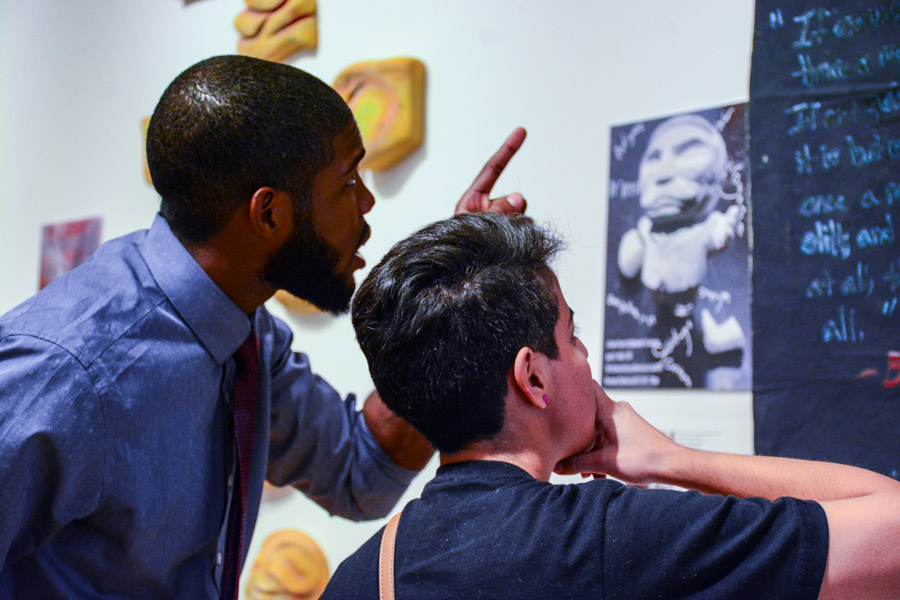
Senior Projects, Spring 2022
April 22 - May 6, 2022
Wasmer Art Gallery and ArtLab
Presentation of Artists, 5 - 7pm, Thursday, April 21, 2022
At the end of their studies, art majors are required to develop and present a coherent body of self-generated work. This exhibition combines their knowledge of techniques and concepts while drawing on research of historical and contemporary artists. Each senior art major in the exhibition designs and creates a unique installation that combines their technical skills and conceptual vision.
Sponsored by The Layden Family Foundation, The Smith Family Foundation of Estero and WGCU Public Media
Image credit: Tai Goggins (2017, Art) and Jacq Sanabria (2016, Art) in the Wasmer Art Gallery, Photograph by Caitlin Rosolen de Jesus
-
Brent Carmona THE OUTLIER
Toggle More Info
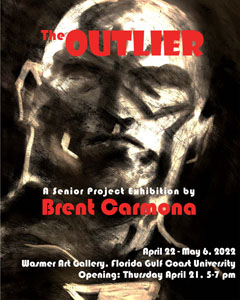
What is it about stories of superheroes that has so captured our imagination and made them the dominant subject matter in film and television for the past two decades? Birthed in comic books in 1938 with Superman, the superhero evolved to reflect the popular concerns and interests of the time. To trace the genre’s roots back further, there are aspects of both classic science fiction and mythological tales emphasizing fantastical ideas and concepts. Science fiction is a genre that exists to critique and comment on some aspect of the world, and by its nature can have a cynical slant. Myths and the heroes they portray are larger than life characters who must overcome great trials. Superhero stories tend to be a combination of these two elements, a protagonist who must rise above impossible odds in a world that seems willing to surrender itself to malevolent forces. This aspirational factor these characters and stories has contributed to their continued popularity in pop culture. This phenomenon is the seed from which this comic story starring my own protagonist, the Outlier, has sprouted from.
These grand stories served as a means of escape from the mundanities of my small-town upbringing. Movies, television, books, and most of all comics have played a big part in my life as far as I can remember. I have vivid memories of seeing Back to the Future for the first time, checking out beat-up copies of the Great Illustrated Classics versions of The Time Machine and Frankenstein from the elementary school library, and reading the comic The Dark Knight Returns in high school. As this fascination continued to develop, I found myself writing and drawing my own stories. I created multiple characters, but the one I kept coming back to is the Outlier. In choosing to craft my own comic story for Senior Project, I seek to gain a deeper understanding of my own views on these classic themes and archetypes. For me, the Outlier is a distillation of all the comic heroes that I grew up with. The quality I found to be the most inspirational was their unwavering commitment to helping others. The ability to maintain this outlook and worldview when constantly facing the worst that humanity has to offer is something I try to apply in my own life in some small way.
For the story itself, after planning out the 20 pages and doing some rough page compositions, I start by drawing out the pages in pen and ink on paper. Then, after scanning, I open the page in Photoshop on my iPad and clean it up and make alterations and add extra details and text. For the individual pieces depicting scenes and characters, I chose the much larger scale to create a physically immersive experience. The materials used for these drawings are simply charcoal and gesso on large-scale paper. I love working this way because it adds grit and texture to any image. I had used these methods before and was aware of the smoky, heavy atmosphere that it could create. The process is a spontaneous exchange between drawing in charcoal, smudging, layering gesso, and scratching into the piece. The combination of these two contrasting methods allow me to explore different perspectives and visual interpretations of the character and story of the Outlier.
-
Breah Fyffe CONTEMPLATION
Toggle More Info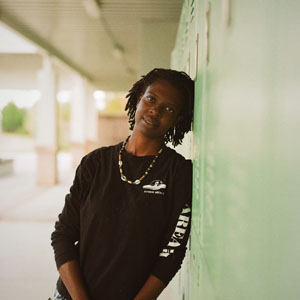

Bring your focus to the breath,
Inhale…
fill your lungs with energy, positivity, growth and love
Exhale…
release all worries, fears, doubts and anxieties
Empty your mind, allow yourself to rest
Bringing yourself to the present moment, taking it one step at a time
Taoism is an ancient philosophy and religion. Dating from 206 BC (Han Dynasty, China) to current times in various regions around the world, Taoism concentrates on the individual life and personal tranquility. Tao or “The Way” holds no supreme being and is the void from which all reality emerges, so vast that it cannot be described in words. Amongst the teachings of the Taoist philosophy are the acceptance of change as it is an absolute reality, and that all things and transformations can be unified in harmony with the Tao. De or “inner power” is a psychological condition of balanced and focused awareness from which the practitioner can respond instinctively, spontaneously and harmoniously to whatever may arise, in order to reach a state of Wu Wei or acting in accordance with nature. This concept was typically embraced through poetic and artistic endeavors, creating works that would satisfy personal wellbeing rather than producing work that for the elite.
I have been intrigued with the philosophical approach of Taoism and chose to implement these teachings in my art-making process to explore change between mediums. As a child my mind was constantly racing with the wonders and curiosities this world has to offer. Yet as I aged these child-like marvels have evolved into anxious thoughts about the realities and truths that this world contains. I experienced my first panic attack in high school, but I didn’t identify this event as such until a few years later. It wasn’t until recently that I have been able to work through these experiences in my life through activities such as contemplative practices. For my Senior Project I have found a connection to the Taoist philosophies of seeking balance through the act of letting go to the will of nature. Through the mindful acts of artmaking, my commitment to Brazilian Jiu-Jitsu, and contemplative practices such as yoga I manage my emotional states of being, thus allowing myself to be more flexible to the constant changes of this life.
I created my sculptural works with a stoneware clay body that was first wheel thrown in order to create a structurally sound base, and then built upwards with coils produced with a handheld extruder. I would continuously slip and score the extruded coils to emulate organic growth, merging the coils with a calabash gourd to develop textural effects that recall the creation process. Alongside the construction of these sculptures, I developed complementary drawings in gesso and charcoal achieved through the layering of pigments to highlight the qualities of the varying heavens in Taoist philosophy. I then created collagraph prints which also involved the use of gesso as well as materials such as tissue paper and twine. Finally, I deconstructed my collagraph imagery, cutting and adhering them onto a separate sheet of paper. Through this multistage, multimedia approach to reimagining the original sculpture I am continuously learning, working with rather than against the process of change.
-
Alex Gottsch AS THE LIGHT DIMS
Toggle More Info
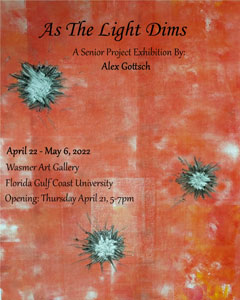
“Remember me when I am gone away,
Gone far away into the silent land;
When you can no more hold me by the hand,
Nor I half turn to go yet turning stay …”- Christina Rossetti (Remember, 1849)
Cognitive decline and memory loss are unfortunate characteristics of aging which are devastating to the person and to the family. Dementia is a broad term covering several types of memory loss; through our lives there are many factors that can cause dementia at any age but is generally found to begin to occur from fifty to sixty years old. Certain types of dementia such as Alzheimer’s Disease and Huntington’s Disease can be genetically tested prior to the development of the disease. Other varieties develop over time while one ages or are a result from specific brain injury. With most types of dementia there are stages through which the brain degrades over a period of time. I have watched those closest to me suffer through memory loss and have witnessed the progression of the disease, feeling worried and heartbroken as their cognitive decline develops.
It is because of my own exposure to the conditions of memory loss that I chose to focus on the cognitive decline of dementia for my Senior Project. This semester I am also engaged in a therapeutic program called Opening Minds Through Art where I help those with dementia to explore their creative choices. It was always my intention to pursue a graduate degree in Art Therapy, and I have been accepted into the Master’s Program at Florida State University for Fall 2022. To prepare myself for this career path I have combined the B.A. Art degree at FGCU with a minor in Psychology to better understand the foundations for art therapy. I am using the clinical stages of memory loss through dementia as the specific content of the artwork I have created for my Senior Project exhibition.
This body of work began with matching my representation of dementia to two-dimensional and three-dimensional media. For Alzheimer’s Disease I have chosen ceramics for its tactile and physical properties to explore the seven stages of critical dementia. To convey the disintegration effect, I used a range of cutting and carving tools to scrape and imprint texture into the clay and cut holes into the slabs to show how the ventricles and other parts of the brain degrade. Monotypes are single prints that are taken from a design that is created using printing ink. In using printmaking monotype methods, I focused on Multi-Infarct Vascular Dementia, in which small pieces of dead tissue in the brain develop due to lack of blood flow. While working with this content has been very difficult for me, my intention is to bring to light the physical and mental realities of those who suffer with dementia.
-
Sloane Leiva A QUIET SPACE
Toggle More Info

“I fight pain, anxiety, and fear everyday, and the only method I have found that relieves my illness is to keep creating art. I followed the thread of art and somehow discovered a path that would allow me to live.” -Yayoi Kusama
Every aspect of my installation incorporates what I love most about art. The moment I sit down to start drawing repetitive marks or carving into clay is when I finally feel at peace. My home is where I find sanctuary, serenity, and escape from the stresses of the world, where I can focus on my creativity. So much chaos is contained within the borders of my mind that sometimes it consumes me and spills over. I manage this chaos though the act of repetitive, patterned drawings whether on paper, in clay, or brushed onto objects. My Senior Project exhibition, A Quiet Space, is a safe place for me to escape from an anxious reality and find healing.
For as long as I can remember, I have been making art and struggling with mental health challenges. Art has always been a form of escapism and relief for me. Mental illness is a subject many shy away from, however over the recent years it’s become a problem our society cannot continue to ignore. I have personally struggled with anxiety and depression for many years now and repetitive mark making has been an effective and healthy way for me to cope with life’s difficulties. This exhibition has given me a chance to really explore my technique of “doodle art” therapy and compulsive mark making on a larger scale and in a more contemplative way.
For this project, I chose to use a range of media and methods including drawing, printmaking, ceramics, and embellished found objects. I used Micron ink pens to create precise line drawings with repetitive marks and patterns. I added several strips of commercial Washi tape to the drawings to create highlights of color. For the monotype series I applied Akua ink to Strathmore printmaking paper to create spontaneous dynamic patterns. I used my drawing experience combined with ceramics to create a series of handmade incised tiles decorated with underglazes and clear glaze. I included a series of found objects to bring a familiar and comforting feeling to my installation, and each object is hand painted with Posca paint pens. I want to give people an open window to peer into my head and see the chaos that ensues, and the methods I use to diffuse that chaos. This exhibition transforms mental illness into art and makes it healthy and beautiful.
-
Daniela Martinez SEEING RED
Toggle More Info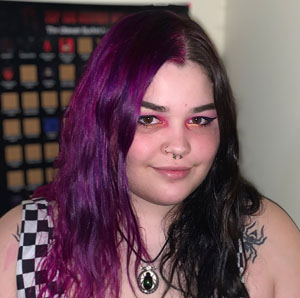
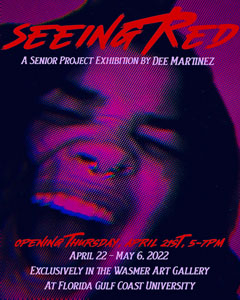
“I’ve had men trying to shut me up since I was a little girl. What is it about little girls that scares men so much?”
– Valeria Solanas, American Horror Story, Cult (2017).
Women quickly learn that we live in a different world than men; we have a history of being ostracized, objectified, and disregarded as well as branded as hysterical, melodramatic, and hypersensitive. It wasn’t until the 19th century when the issues women faced were brought to light during the first wave of feminism, and even then, the fight was only for the rights of heterosexual upper-class women. We are now in the midst of the third wave of feminism which highlights issues for women of color and the LGBT+ community, also known as intersectional feminism. The evidence of this systemic oppression is not only documented throughout history, but is illustrated in popular culture, especially in cinema. While we still see our fair share of over-sexualized and unnecessarily terrorized women in film, I applaud the ones that break that stereotype to give us powerful and resilient women with rich character development. The genre of horror specifically, has become a platform where women can explore more complex roles. In films like The Craft (1996) and Hereditary (2018), both featured in my exhibition, we can watch female roles transform from supplemental side characters to powerful lead roles and rightfully so. The femme fatales of horror are a force to be reckoned with, demonstrating some of the most visceral emotions on screen all while fighting for their lives. Horror movies have generally been considered to be preffered by men (roughly 58% male audience), but as we begin to see more empowered representations of women in the genre, the gap will continue to close.
As a little girl, I favored movies about princesses and talking animals. I was also scared of everything, thunder, the dark, even a sweater hanging on my door. Somewhere along the lines I decided to put my big girl pants on and went head-first into the world of horror. Once I got past the initial shock of it all, I found a pattern in my favorite horror flicks. They feature dynamic roles that offer some insight into the female experience through the lens of horror. These women are often angry and vengeful, characteristics we are not generally praised for showing. The genre has developed into a place where we can illustrate the perspectives of women to a broader audience in a way that is empowering and entertaining. For my senior project exhibition, I focus on movies that feature stories centered around the experience of the main female characters who face obstacles that are unique to women. Seeing how far the roles of women have come, my love for horror movies has made me braver. I, myself have struggled with stifling my emotions for the sake of others, so I’ve come to find myself with a strange sense of peace when watching horror, seeing women release feelings that I’ve hidden.
Seeing Red is a collection of three “scream queens” from some of my favorite horror films that feature strong female leads. Three 18”x20” portraits are sketched out in pencil and illustrated in oil pastels and acrylic paint on vellum paper. They are mounted on boards of Masonite and painted with a mixture of acrylic paint and acrylic gel medium for texture. The color red is a main theme in this work due to the symbolism it carries. Red is the color of our blood as well as being known for the color of passion, anger and in religious context, sin. The portraits are colored with warmer shades and tints of red and mounted on the Masonite painted with a cooler toned red to add contrast. I wanted to translate the intensity of the emotions felt by the subjects with vibrant colors and dynamic expressions. It was important to me that the color pink is included not only because it is a symbol of femininity, but also the combination of red and white, which often symbolize passion and purity. My senior project exhibition is an ode to the evolution from girlhood to empowered woman.
-
Colin Oakes MENTAL NOTES
Toggle More Info
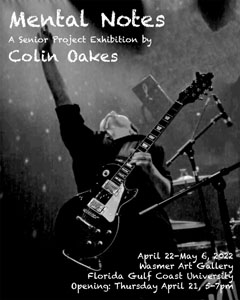
Anxiety, stress, low self-esteem, and declining self-worth are all things we experience in our lifetime. Everyone has these perfectly normal feelings, but the challenge is knowing how to deal with them. This struggle is particularly evident in young adults. Since the COVID-19 pandemic took over in early 2020, finding solitude to handle the struggles of these anxious feelings, whether they involve dealing with work, education or social situations often require real therapeutic assistance to move forward. That assistance has always been complimented by the arts of the world such as movies, comedy, and most of all, music. Music is in everyone’s hearts; since the moment we are born, our ears are our memory, our navigation, and our healing.
For my Senior Project, I chose to paint the duality of music and mental health because, to me, music is the one thing that helps people through the hard times in life. Music soothes the brain, and allows it to find solitude and tranquility, regardless of the genre. I often listen to alternative, punk, blues, and even just regular rock and roll music and to this day, there is always something within that force that makes me feel whole, motivated and able to move forward. As an individual struggling with obsessive compulsive disorder (OCD), high-functioning autism, I wanted to compare the ways in which I listen to and play music, and how I react to it on a daily basis. In my darkest hours, I have a severely hard time navigating through life and society and it is the familiar sound of music in my head that makes it possible for me to cope. In this exhibition, there are nine duality paintings, five of them represent a self-portrait of how I experience the healing of music, whether with a microphone, an instrument or with head phones and the other four of how I experience my worst anxiety and fears without the solitude of music.
For these self-portraits, I chose to incorporate mixed media including acrylic paint, oil paint and pastel. I began by using acrylic paint as the main medium for self-portraiture with a more expressionistic and representative style of painting for the darker emotions of my project, sometimes adding pastel for different features. I wanted to make the color effect of each one complementary, monochromatic or even triadic for the differentiation. I would paint the backgrounds with particular colors, mostly primary and secondary, sometimes with sponges and palette knives. When drawing the self-portraits, I typically use natural skin tones for the clean ones and expressionistic and exaggerated layered colors for the darker ones. For the backgrounds of the paintings, I added chaotic textures for the negative side, and transparent line rhythms of different wavelengths for the positive side to represent sound waves and music notes.
-
Al Payne CONSCIOUS (WHERE WE MEET)
Toggle More Info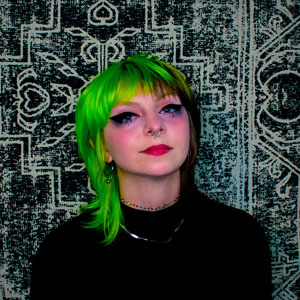
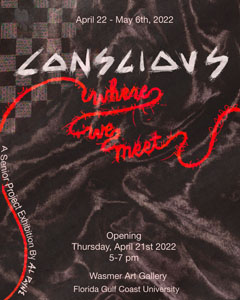
“We are the cosmos made conscious and life is the means by which the universe understands itself.” -Brian Cox
Coming into adulthood in a global pandemic catapulted my thought patterns into spaces leading towards one root concept: consciousness as a living being. At the time I felt alone in my moments of deep reflection on the nature of life and its properties. These explorations and even revelations were isolating experiences at a point where many of us lost our connection to others. I have wondered if this recent onslaught of global phenomena and the increasingly solitary conditions they manifested have broken our collective consciousness. It was through these conditions that I reexamined my severed and neglected relationships and realized the critical value of the connections in my life.
I began again to fall in love with the company of another’s consciousness – the genuine two-way flow of energy that only sentient individuals can share in each other's company. These bonds and ties have become the inspiration that recolors the lens of my life. To be alive is not a solitary experience - we do not exist in a vacuum. To demonstrate this idea of interconnectedness I chose to create a composite collection of painted and collaged mixed-media images of some of (but certainly not all) the beings in my life that I am tied and bonded to. This is not a series of portraits but rather a single piece: take down one part of the installation and the rest will begin to unravel. Our deepest and most honest attachments to other points of consciousness operate similarly: as they are the thread of the fabric that holds us together. It is our connections to others that stitch and ultimately reassemble our frayed seams.
This abstract concept of consciousness and connection offered endless freedom in terms of material and approach. I chose to focus primarily on painting because this process for me is symbolic of the flow of thought - the blending of colors and shapes and strokes that all unify into a single, tangible object. Rather than the traditional rectangular blank canvas I chose to use found elements in my portraits. For each portrait I selected secondhand/found fabrics to stitch together as the canvas and added collage elements to provide a perceptible proof of each being's consciousness. From each collaged study and portrait extends red yarn as the visual manifestation of the flow of thought and awareness to each other. It is through this concept that the red yarn becomes the heartline of my installation, quite literally tying it and us together.
-
Darius Pierce GARDEN OF MY AFTERLIFE
Toggle More Info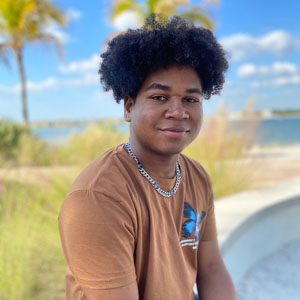

I have always thought about what will come of life. What is the purpose? What is the context for it? When will it end? What will it look like at the end? Different regions and religions have their own narratives on what is generally identified as the afterlife and how this alternative existence is experienced. The afterlife refers to the mind/soul/spirit’s part in the universe after it has been separated from the physical world. Through the presented body of work, I have explored what I wish to see in my afterlife. In my family, we hold the Christian values that notes the existence of heaven, where the soul is directed to salvation according to its evaluation by God. However, we tend to view heaven as a personal accommodation based on each soul’s desires and coveted values, with each soul having their own garden of life that they experience. In this way the soul is rewarded for follow the right path during their lifespan.
I have thought of my personal heaven/garden as consisting of my favorite aspects and memories from my life that I hold close to my heart and soul. Within my work, I have focused on preserving these things through printmaking so that I can render them in a memorialized way. With the series of solarplate prints, I have chosen the most important people in my life who encapsulate my happiness at that moment in time. I also included aspects of myself that I find to be defining factors in my soul. These aspects range from activities to qualities that I hold in high esteem. For the series of linocuts, I have capitalized on the characteristic of myself that fall into the overall concept of curiosity. The instances of floriography, equestrienne work, studying of hair, and fascine.
By utilizing solar plate and linoleum printing, I work to create a solid and cohesive approach to show my link to the key points in each composition. I held a connection to the natural/spiritual world within each of my works. For both the solarplates and linocuts, I decided to use Speedball Professional relief ink for a mix of black with burnt umber hansa yellow and cadmium red to create a non-flat pigment for the black color. I use photographs of my family and I in different settings burned onto solar plates. They all are to describe my relationship with the memory and how important it is to my happiness by the order of size relationships. I am carving the activities and qualities from my life on linoleum. This medium allows me the most control over the linear qualities of my content. With that, I can allow more focus to be placed on the content with the additional aid of the dark colors/tonal values that play a part in the overall composition. This is to relate more to the concept of the garden and after-worldly components.
-
Marcela Pulgarin THE TIME I INHABIT
Toggle More Info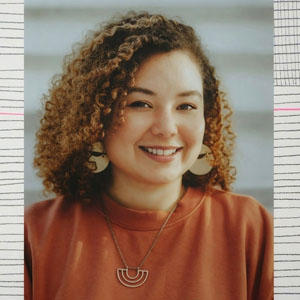
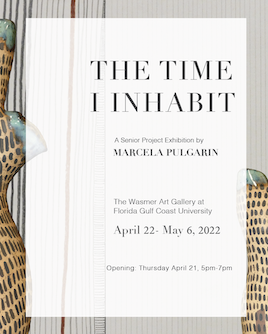
"To spend time is to explore time" - Edmund De Waal.
The passing of time is a concept that we all experience, whether we are keenly aware of it or completely oblivious to its consequences. According to the Greek philosopher Plato, time is an idyllic form, Eidos, the essence of an idea that surrounds us with an invisible veil of appreciation and urgency. As adults, we experience time differently than children, which allows us to engage in a mindful understanding of time. As we grow up, we become more acquainted with the time we have spent and the time we have left. Time rules our entire existence; the way we perceive and construct our self-image and idiosyncrasies is fundamentally based on how we use time. Our awareness of time allows us to better understand the implications that change brings over time, that is why for my Senior Project I chose to explore the relationship between physical time and the sequence of experiences that have shaped my life. I intend to visually represent the passing of time through the accumulation and layering of experiences that construct my human condition.
I am fascinated with the serendipity of my own life. As a child, I never imagined the possibilities that my future had to offer. I didn't give much thought to time for the first eighteen years of my life in Colombia, and when I did, all I wanted to do was to fast-forward. In 2007 I moved to the U.S. and ever since I’ve been exposed to new cultures and belief systems that have changed how I perceive the world, myself, and especially time. In this installation piece, I want to take ownership of my time and visually recreate the time-lapse I believe has made me who I am today. The eighteen drawings represent the time I spent in Colombia, and they explore sentiments about family and identity. The fourteen floating clay drawings illustrate my time in the United States, exploring transition and self-discovery. Finally, the thirty-two vessels represent my current age and act as a tangible visual aid that helps me understand the time in which I exist. I first encountered clay in 2019, a material I didn't have access to when I was growing up. I chose clay and mark-making as my medium to represent the evolving dynamics of life, and to create a sense of continuity through the marks made on the paper and the clay. I intend the viewer to assimilate the installation as the accumulation of many hours of work, and many years of effort, that will keep continuing in the future.
The drawings are made using toned paper, graphite, markers, and acrylic paint. I spent time with the marks and recreated complex memories with lines and geometric shapes. I am inspired by the idea that abstraction removes unnecessary information and allows me to focus on the use of primary forms to convey a complex idea. The clay drawings are made of porcelain by rolling thin slabs and then crumpling them to replicate discarded paper. Lines are carved into the surface, and inlayed with underglazes following the initial firing. The thirty-two vessels were made by hand using the coiling method, which lets me observe the behavior of the clay as I develop the final shape. Finally, I used commercial Amaco glazes fired at 2167°F to obscure some of the marks on the vessels in order to show change and transformation.
-
Rebecca Salas IN THE DARK I ALWAYS FEEL LIKE SOMETHING'S STARING AT ME
Toggle More Info
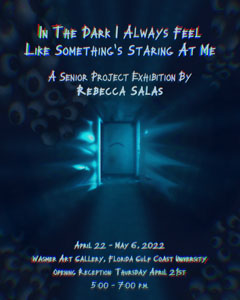
There are many psychological factors that contribute to why we fear both the known and the unknown. In the eyes of evolution, as a species we’ve grown to be naturally fearful of predators that pose dangerous threats to our survival. Genetically, specific fears and anxieties are passed down for generations creating entire family trees full of anxiety. There is even evidence that fears can be conjured just by hearing about them in a social setting. Then there are more commonly obtained trauma-induced fears where the individual has gone through a scarring emotional or physical event that causes them to completely avoid the stressor. The term fight or flight is an accurate description of what happens to a person's body during a frightening situation.
For my senior project, I chose to frame all of the entities I’m afraid of. At this point in my life, my list of fears is longer than what I’m not afraid of. To cope I have found ways through art to create something beautiful out of something horrifying, and have come to terms with my anxieties. Flower Flood is a triptych based on my fear of thunderstorms and natural disasters. When I was younger I would have terrible meltdowns over thunderstorms, and my mother would tell me to pay attention to the smaller things happening throughout the storm, to “look at how the blades of grass are happily dancing around because they’re being fed and cared for.” Just Plane Wrong is composed of 3 panels that explore my fear of airplanes. The view through the airplane window shows the potential tragedy of airplanes raining out of a storm. I Didn’t Mean To Scare You is based on my fear of the paranormal. It is believed that ghosts are just lost souls and they don’t mean to scare you, they just don’t know where to go. Something Staring is based on my fear of the dark and having the feeling that there is always something there staring at me. The bottom panels are broken to represent the idea that this is an issue that I still deal with and can’t be contained.
Each of the works in this exhibition is framed by a window; the dilapidated windows frame the fears that I am still grappling with, while the sturdier, more intact windows represent the fears I’ve been able to control. I have used unconventional surfaces and found objects such as wood, masonite, and glass to represent these ideas. Most of the masonite panels come from previous projects that I had done. The frames were found in various thrift stores, and I have added sand and layers of paint or varnish to enhance the already aged look. The web for Distracted is created using fine silver embroidery thread hand-sewn into the canvas, while the spider is constructed with canvas and wire to make malleable legs. Fear is a Mirror is made from broken porcelain dolls and red vinyl to match the reflectiveness of the mirror.
-
Laina Seraphine AN ILLUSION OF PERMANENCE
Toggle More Info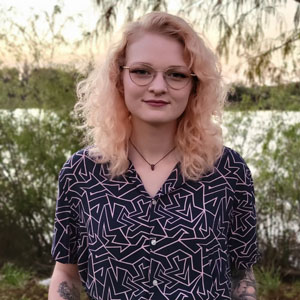
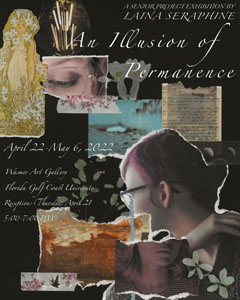
“Unless you learn to face your own shadows, you will continue to see them in others, because the world outside you is only a reflection of the world inside you.”
– Carl Jung
The act of existing brings a constant flow of experiences as we move through life. These experiences are dominated by those with whom we choose to surround ourselves. The relationships we have with other human beings, no matter how long, can have equal impact on your life. We each have our own way of living; a belief system, standards of behavior, morals, and values that we hold ourselves to. Due to those differences, this can potentially lead to some negative interactions with others. On the other hand, we may bond with those who act and believe in ways that we sympathize with and find ourselves holding those individuals close. Whichever side of the spectrum they fall on, we judge others based on personal experience. The behavior of others is observed from our perspective, and centered on how we think and feel, rather than how they intend.
The influential relationships that I have experienced have shaped me into who I am today. I will never really be “complete” because I will continue to meet new people, have new experiences, and grow connections. However, I can choose how much power a current or past relationship has over me in the present moment. It is easy to let the negative encounters control my brain and actions, but I have decided to take back my personal power as a self-determined human being. This series of portraits focuses on the most influential relationships experienced in my life, and the imagery I associate with each of them. The negative influencers who are part of my past are fading into the darkness, becoming memories made up of symbols and metaphors, now fragments of that which does not control me any longer. The portraits of those who currently have the most positive and healthy impact on my life are accentuated by light. These are the people that I choose to hold close. Each of the portraits share a black background, symbolizing the space they occupy in my mind when I close my eyes.
Making the work for this exhibition began with producing a series of smaller studies. I made charcoal drawings and added collage elements so that I could establish relationships within the portraits themselves. This technique also helped to ensure the contrast between light and dark was enhanced. Using the studies as a reference for the final piece, I painted the dark backgrounds and the first layer of the face and background on a wooden panel. Additional features of the portrait were completed on rag paper. For the symbolic imagery, I began by venturing out to a few places to capture some photos, including the Buckingham property and Koreshan Park. I then used the paintings and photos, in addition to materials such as pressed flowers and decorative papers to adhere on top of the paintings in layers. Once all the elements were added, the work was sealed with an acrylic coating spray.

